ASD-Notes
My notes on Advanced-Software-Development
Design Patterns
- Design Patterns
- Responsibility-Driven Design
- GRASP
- Use Case Realizations
- GoF Patterns
- Conclusion
- Resources
Design Patterns
Class Design and Unified Process Terminology
- UP = Unified Process
- Typical information in a Design Class Diagram includes:
- Classes, associations and attributes
- Interfaces (with operations and constants)
- Methods
- Attribute type information
- Navigability
- Dependencies
- The Class Design depends upon the Domain Model and interaction diagram
- The UP defines a Design Model which includes interaction and class diagrams
Domain Model versus Design Model
- Domain Model is the analysis class diagram
- Don’t show methods

- Design Model shows methods and visibility (arrowhead on association)
- Register has reference to Sale; Sale des not have reference to Register

Sample UP Artefact Relationships
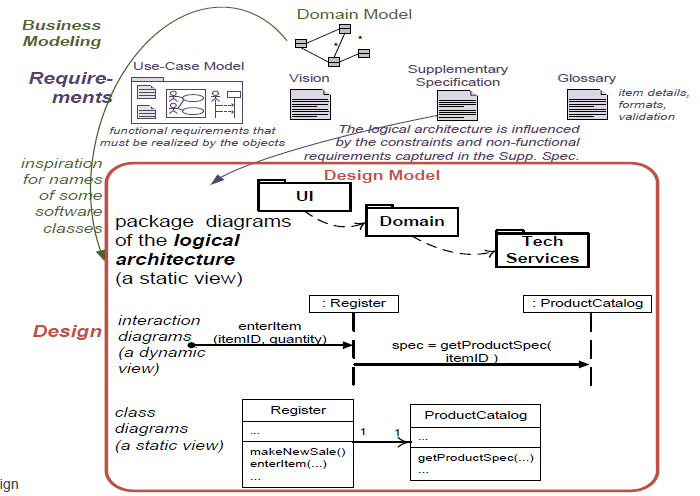
Responsibility-Driven Design
- RDD: software objects have responsibilities (an abstraction)
- a
Saleis responsible for creatingSalesLineItems(doing) - a
Saleis responsible for knowing itstotal(knowing)
- a
- Metaphor for thinking about OO design
- Big responsibilities take lots of classes and methods
- “provide access to relational database”
- Subsystem with 100 classes and 1000 methods
- “provide access to relational database”
- Small responsibilities may take one method
- “Create a sale” - one method in one class
- A responsibility is not a method, but methods fulfil responsibilities
Responsibilities and Methods
Object design is about identifying classes and objects, and their methods, and how they interact.
- Responsibilities relate to the obligations of an object
- Two types of responsibilities
- Doing
- Doing something itself (e.g.: creating an object, doing a calculation)
- Initiating action in other objects
- Controlling and coordinating activities in other objects
- Knowing
- Knowing about private encapsulated data
- Knowing about related objects
- Knowing about things it can derive or calculate
RDD and Collaboration
- Doing
- Responsibilities are implemented with methods that either act alone or collaborate with other methods and objects.
- The
Saleclass might define one or more methods to know its total; say, a method namedgetTotal - The
Salemay collaborate with other projects, such as sending agetSubTotalmessage to eachSalesLineItemobject asking for its subtotalDefinition: Responsibilities
- The
- Responsibilities are an abstraction
- The responsibility for persistence
- Large-grained responsibility
- The responsibility for the sales tax calculation
- More fine-grained responsibility
- The responsibility for persistence
- Responsibilities are implemented with methods in objects
- 1 method in 1 object
- 5 methods in 1 object
- 50 methods across 10 objects
Responsibilities and System Sequence Diagrams
- Within the analysis artefacts, a common context where these responsibilities (implemented as methods) are considered is during the creation of sequence diagrams
- Sale objects have been given the responsibility to create Payments, handled with the makePayment method
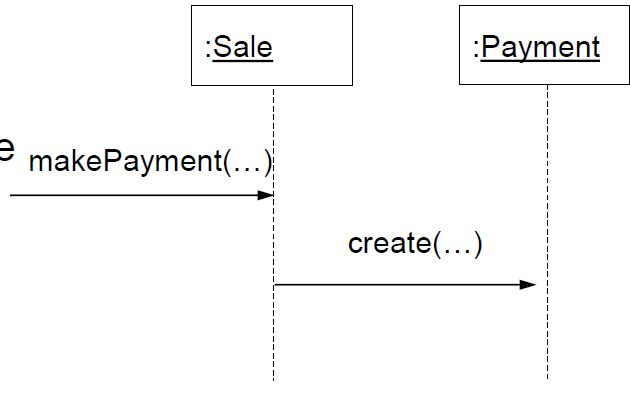
GRASP
I don’t quite GRASP this section :wink:
- Design Objects with Responsibilities
- A critical skill is designing or thinking in objects
- This can be practiced based on explainable principles
- Question: What guiding principles to help us assign responsibilities?
- One answer:
- General Responsibility Assignment Software Patterns - GRASP
- Very fundamental, basic principles of object design
- Patterns are named problem-solution pairs to common problems, typically showing a popular, robust solution
- “Facade”, “Information Expert”
- They provide a vocabulary of design
Patterns
- Principles (expressed in patterns) guide choices about where to assign responsibilities
- A pattern is a named description of a problem and a solution that can be applied to new contexts;
- it provides advice on how to apply it in varying circumstances
- For example:
- Pattern name: Information Expert
- Problem: What is the most basic principle by which to assign responsibilities to objects?
- Solution: Assign a responsibility to the class that has the information needed to fulfil it
Four elements of Pattern Templates
- Name
- Increases our vocabulary
- Frequently see “Also Known As”, AKA
- Indication of a naming problem
- Problem
- Describes problem, inherent trade-offs and context
- Solution
- General description of how to solve the problem
- abstraction of an entire family of similar solutions
- General description of how to solve the problem
- Consequences - usually required
- Each solution has trade-off and consequences
- Solutions can cause or amplify other problems
- Costs and benefits should be compared against
Nine Grasp Patterns
- Costs and benefits should be compared against
Information Expert
AKA - Expert
- What is most basic, general principle of responsibility assignment?
Assign a responsibility to the information expert - the class that has the information necessary to fulfil the responsibility
- “That which has the information, does the work”
Example
- What software object calculates sales total?
- What information is needed to do this?
- What object or objects hsa the majority of this information
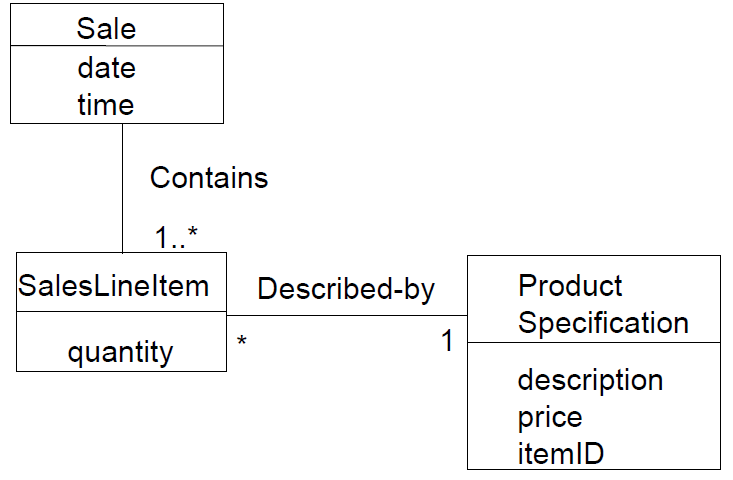
Answer:
- It is necessary to know about all the
SalesLineIteminstances of a sale and the sum of the subtotals - A Sale instance contains these, i.e. it is an information expert for this responsibility
Definition continued:
- To fulfil the responsibility of knowing and answering the sale’s total, three responsibilities were assigned to three design classes
- The fulfilment of a responsibility often requires information that is spread across different classes of objects. This implies that there are many partial experts who collaborate in the task.
| Class | Responsibility |
|---|---|
Sale |
Knows Sale total |
SalesLineItem |
Knows line item total |
ProductSpecification |
Knows product price |
Creator
- Problem: Who should be responsible for creating a new instance of some class?
- Solution: Assign class C the responsibility to create an instance of class X if one or more of the following is true:
- C aggregates X objects
- C contains X objects
- C records instances of X objects
- C closely uses X
- C has the initializing data that will be passed to X when it is created (thus C is an Expert with respect to creating X)
- The more the better
Example
- In the POS application, who should be responsible for creating a
SalesLineIteminstance? - Since a
Salecontains manySaleLineItemobjects, theCreatorpattern suggests thatSaleis a good candidate.

Controller
- What object in the domain (or application coordination layer) receives the requests for work from the UI layer?
- Solution: Choose a class whose name suggests:
- The overall “system”, device or subsystem
- A kind of facade class
- Or, represents the use case scenario or session
- The overall “system”, device or subsystem
- Problem: Who should be responsible for handling an input system event?
- Solution: Assign the responsibility for receiving or handling a system event message to a class representing one of the following choices:
- Represents the overall system
- Represents a use case scenario
- A Controller is a non-user interface object that defines the method for the system operation
- Note that windows, applets, etc. Typically receive events and delegate them to a controller
Low Coupling
- Note that windows, applets, etc. Typically receive events and delegate them to a controller
- Coupling: it is a measure of how strongly one element is connected to, has knowledge of, or relies upon other elements
- A class with high coupling depends on many other classes (libraries, tools)
- Problems because of high coupling:
- Changes in related classes force local changes
- Harder to understand in isolation; need to understand other classes
- Harder to reuse because it requires additional presence of other classes
- Problem: How to support low dependency, low change impact and increased reuse?
- Solution: Assign a responsibility so that coupling remains low
Example
- Assume we need to create a
Paymentinstance and associate it with theSale. - What class should be responsible for this?
- By
Creator,Registeris a candidate Registercould then send anaddPaymentmessage toSale, passing along the newPaymentas a parameter- The assignment of responsibilities couples the
Registerclass to knowledge of thePaymentclass
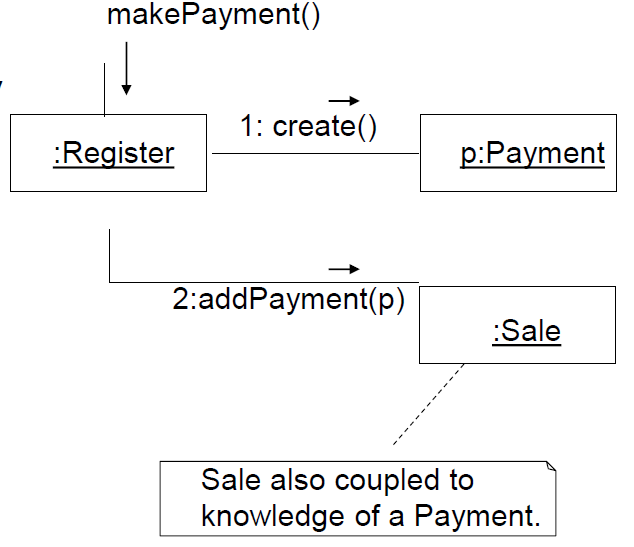
- An alternative solution is to create
Paymentand associate it with theSale - No coupling between
RegisterandPayment
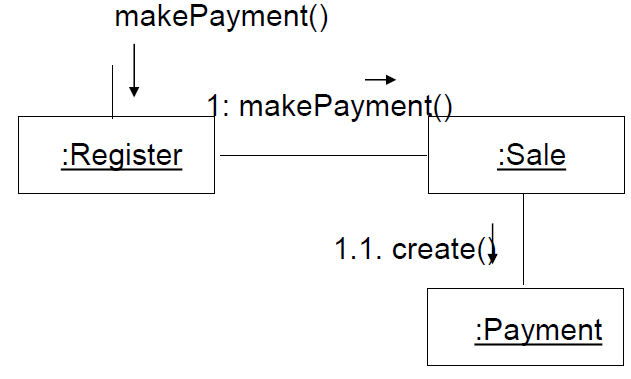
- Some of the places where coupling occurs:
- Attributes: X has an attribute that refers to a Y instance
- Methods: e.g.: a parameter or a local variable of type Y is found in a method of X
- Subclasses: X is a subclass of Y
- Types: X implements interface Y
- There is no specific measurement for coupling, but in general, classes that are generic and simple to reuse have low coupling.
- There will always be some coupling among objects, otherwise, there would be no collaboration
High Cohesion
- Cohesion: it is a measure of how strongly related and focused the responsibilities of an element are.
- A class with low cohesion does many unrelated activities or does too much work
- Problems because of a design with low cohesion:
- Hard to understand
- Hard to reuse
- Hard to maintain
- Delicate, affected by change
- Problem: How to keep complexity manageable?
- Solution: Assign a responsibility so that cohesion remains high
Example
- Assume we need to create a Payment instance and associate it with Sale. What class should be responsible for this?
- By Creator, Register is a candidate.
- Register may become bloated if it is assigned more and more system operations.
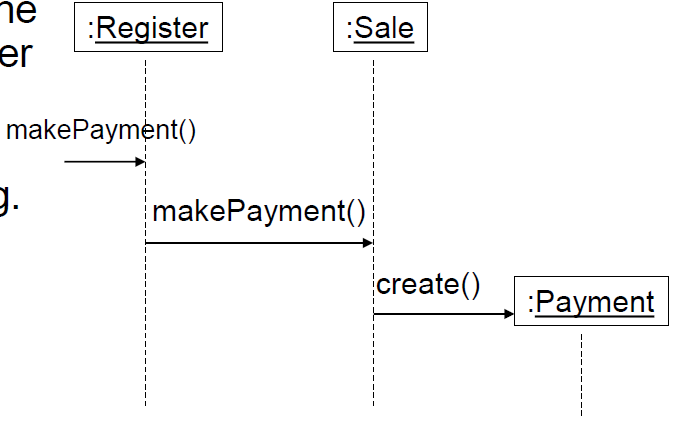
- An alternative design delegates the Payment creation responsibility to the Sale, which supports higher cohesion in the Register
- The design supports high cohesion and low coupling.
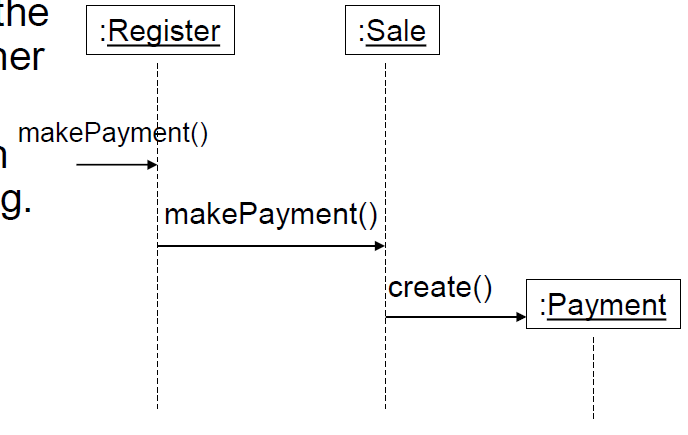
- Scenarios that illustrate varying degrees of functional cohesion
- Very low cohesion: class responsible for many things in many different areas
- e.g.: a class responsible for interfacing with a database and remote-procedure-calls
- Low cohesion: class responsible for complex task in a functional area
- e.g.: a class responsible for interacting with a relational database
- High Cohesion: class has moderate responsibility in one functional area and it collaborates with other classes to fulfil a task
- E.g.: a class responsible for one section of interfacing with a database
- Rule of thumb: a class with high cohesion has a relative low number of methods, with highly related functionality, and doesn’t do much work. It collaborates and delegates.
Coupling and Cohesion
- High Cohesion typically implies Low Coupling
- Low Cohesion typically implies low coupling
Polymorphism
- Problem: How to design for varying, similar cases?
- Solution: Assign a polymorphic operation to the family of classes for which the cases vary
- E.g.: draw() which can be called for various shapes
- Square, Circle, Triangle
Pure Fabrication
- Problem: Where to assign a responsibility, when the usual options based on Expert lead to problems with coupling and cohesion, or are otherwise undesirable?
- Solution: Make up an artificial class, whose name is not necessarily inspired by the domain vocabulary
- E.g.: in Register-Sales-Payment Example
- ReceiptPrinter
Indirection
- ReceiptPrinter
- Problem: A common mechanism to reduce coupling?
- Solution: Assign a responsibility to an intermediate object to decouple collaboration from 2 other objects
Protected Variation
- “Information Hiding”
- Problem: How to design objects so that changes in these objects do not have side effects on other objects
- Solution: Put a wrapper or interface object around them. The wrapper gives a stable interface and is all that has to be altered when the changes happen
Don’t Talk to Strangers
- Special case of Protected Variation
- In a method, only send messages to “familiars”:
- This or self
- Parameters
- Own attributes (including elements of collections)
- Object created in the method (local)
In other words don’t go down a chain of links to indirectly known “strangers”. This avoids coupling to distant objects.
- Problem: how to pass messages and ensure their security?
- Solution: don’t pass messages in a way that may allow insecurity…(?)
Use Case Realizations
This section wasn’t covered in a large amount of depth
Definition
- In the vocabulary of the Unified Process and use case modelling, when we design the objects to handle the system’s operation for a scenario, we are designing a use case realization
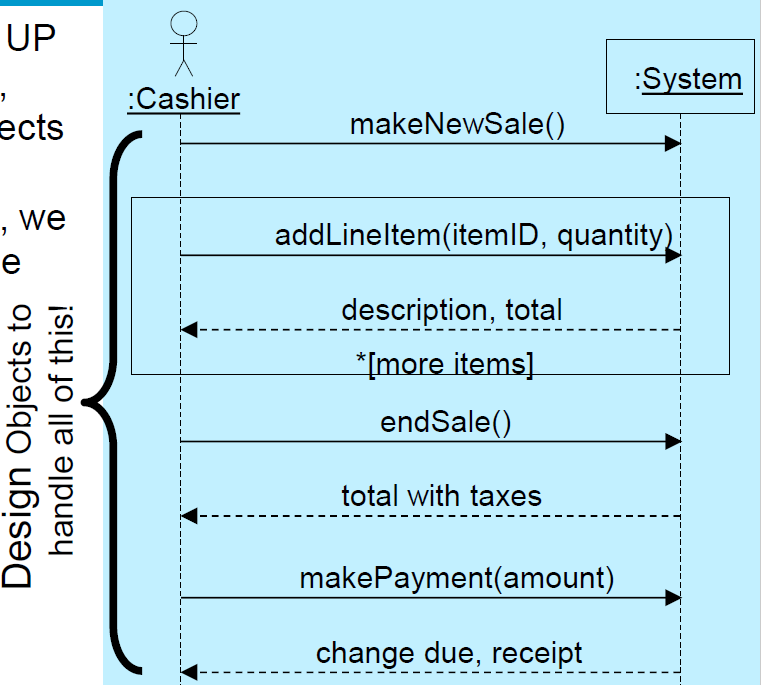
Designing for Visibility
- Fact: To send a message to B, A must have visibility to B. It doesn’t happen by “magic”
- Not a GRASP pattern but important!
- Kinds of visibility
- Attribute (instance variable)
- Parameter
- Local Variable
- Global Variable
GoF Patterns
Reference to the book Design Patterns: Elements of Reusable Object-Oriented Software written by Erich Gamma, John Vlissides, Ralph Johnson, and Richard Helm -who were commonly referred to as the Gang of Four or GoF
Singleton Pattern
- Ensures a class only has one instance, and provide a global point of access to it
- Sometimes we want just a single instance of a class to exist in the system
- Want just one window manager, or one factory for a family of products
- Need to have that instance easily accessible and we want to ensure that additional instances of the class cannot be created
- Benefits
- Controlled access to sole instance
Ensure a class has one instance, and provide a global point of access to it
- Controlled access to sole instance
- Sometimes we want just a single instance of a class to exist in the system
- GoF

Only one instance of a certain class never two. Structure for a unique object or sub-system
Composite Pattern
- Problem: Application needs to manipulate hierarchical collection of “primitive” and “composite” objects uniformly
- Solution: Define an abstract base class (
Component) that specifies the behaviour that needs to be exercised uniformly across all primitive and composite objects. Subclass the Primitive and Composite classes off of theComponentclass. Each Composite object “couples” itself only to the abstract typeComponentas it manages its “children”
Anatomy of a preference dialog
- Aggregates (Composites), called Panels, are used for grouping user interface objects that need to be resized and moved together.
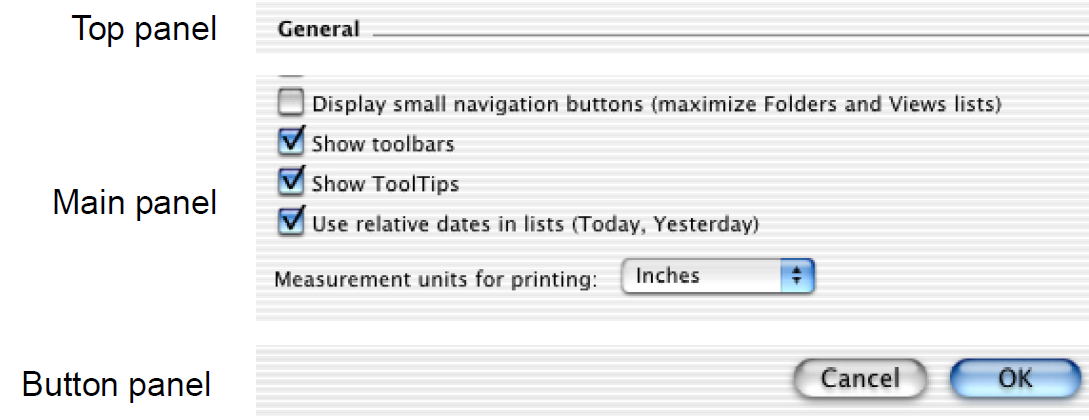
UML Object diagram for UI Preference
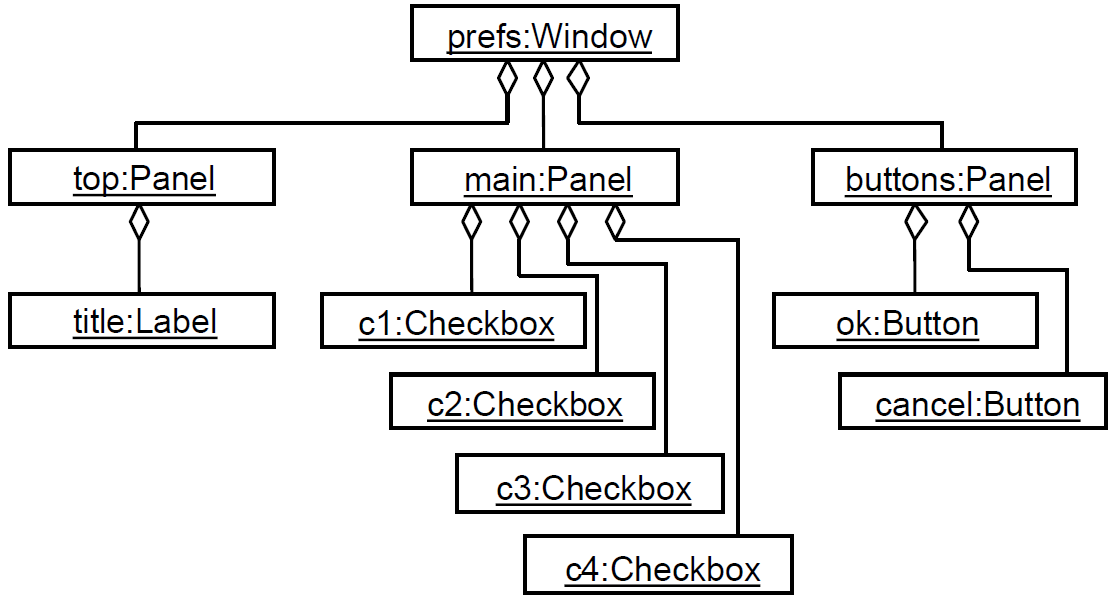
Applying Composite Pattern to UI Widgets
- The Swing Component hierarchy is a Composite
- Leaf widgets (e.g.: Checkbox, Button, Label) specialize the component interface
Facade Pattern
- Leaf widgets (e.g.: Checkbox, Button, Label) specialize the component interface
- Define a single point of contact to the subsystem - a facade object that wraps the subsystem.
Observer Pattern
- Generalization of the MVC pattern
- Want to display data in more than one form at the same time and have all of the displays reflect any changes in that data
- Assumes the object containing the data is separate from the objects which display the data,
- These display objects observe changes in that data
- Liabilities/Concerns
- Possible cascading of notifications
- Observers are not aware of each other and must be careful about triggering updates
- Simple update interface requires observers to deduce changed item
Designing for Low Representational Gap
- Normally we design for a low representational gap between real world and software
- Typically designed objects typically correspond to real world objects
- But (contra-indication):
- Don’t design for low representational gap regarding actors
- E.g.: we don’t make a software class Clerk do all the work in the software system
- Exercise: why?
- Actors do more than one specific class
- It may be sensible to talk about one specific actor
- Separating it out into multiple classes
Conclusion
Summary
- Principles (expressed in patterns) guide choices in where to assign responsibilities
- A pattern is a named description of a problem and a solution that can be applied to new contexts;
- It provides advice on how to apply it in varying circumstances
Resources
- It provides advice on how to apply it in varying circumstances
- GRASP (General Responsibility Assignment Software Patterns)
- Larman
- 2nd Edition
- Chapter 16
- Chapter 17 & 22
- 3rd Edition
- Chapter 17 <- main interest
- Chapter 18 & 25
- 2nd Edition
- Larman
- GoF (Gang-of-Four)
- Larman
- 2nd Edition
- Chapter 23,33 & 34
- 3rd Edition
- Chapter 26, 36 & 37
- 2nd Edition
- Larman